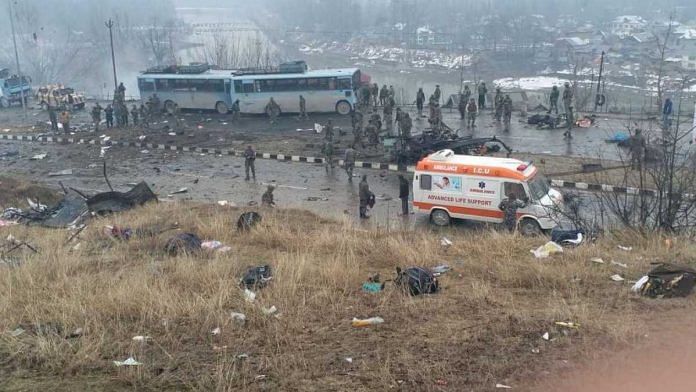New Delhi: The coming months could see more attacks on security personnel in Jammu & Kashmir, including Pulwama-style IED assaults on convoys and poisoning attempts.
According to defence sources, intelligence inputs received over December, January and February suggest terrorists are also looking to target political leaders and journalists in J&K, besides police and Central Reserve Police Force (CRPF) personnel. It was a convoy of CRPF personnel that was attacked by a suicide bomber in February last year — an attack that killed 40 troopers.
While the inputs hint at an uptick in violence in the coming months, the sources cited official data to point towards a slowing trend in parameters of terrorist activity in recent months.
The number of ceasefire violations across the Line of Control (LoC) has registered an increase, but terrorist recruitment is lower, they claimed. The number of terrorists killed has also gone down, according to official data. This, the sources said, was an indicator of fewer encounters and, thus, reduced militant activity.
Also Read: Why Kashmir’s new militancy is harder to defeat than the one in 1990s
Ceasefire violations increase
According to sources in the defence establishment, the number of ceasefire violations peaked in 2019 after the Balakot airstrikes in February and the August scrapping of Article 370.
The number of ceasefire violations in 2019 — 3,168 — was nearly double the figure for 2018, that is, 1,629. The number for 2019 was thrice that of 2017, which was 860.
Of the 3,168 violations in 2019, nearly half — 1,551 — were recorded after 5 August, the sources said. And the trend appears to continue this year. Ceasefire violations for January 2020 stand at 367, higher than the corresponding period in both 2018 and 2017, the sources added.
An Army source said there had also been a calibre escalation by Pakistan in ceasefire violations, with their army now primarily employing artillery as against the small arms used earlier.
“Most of the firing was directed at civilian areas in the south of the Pir Panjal, such as Poonch, Nowshera, Bimbergali, Krishna Ghati areas. Many of those areas are occupied by civilians employed by the Army as porters or in other jobs,” the source added.
“The Indian Army deployment is higher at LoC… since they also defend against infiltrators instead of focusing on dominating the LoC, which is Pakistan’s main objective… That is why the Pakistan army would have more targets to fire at,” the source said.
Other terror parameters down
Other terror parameters, meanwhile, are down, according to official data. Terrorist-initiated incidents were down to 173 in 2019 from 318 in 2018. They were, however, lower in 2017, at 131. Eleven were recorded in January 2020.
The Army source quoted above said it was because of the decrease in terrorist-initiated incidents that the number of terrorists killed had gone down as well. The number of terrorists killed, official data suggests, was 161 in 2019, as compared to 254 in 2018. Eighteen were killed in January 2020.
The majority of these terrorists were killed in the hinterland and not at the LoC, the sources said. For example, of the 161 terrorists killed in 2019, they added, 152 were neutralised in the hinterland, and of the 254 killed in 2018, 215 were in the hinterland. This suggests the presence of a higher number of less-trained homegrown militants than well-trained foreign ones.
Local recruitment of terrorists is down as well, to 119 in 2019 from 217 in 2018, data suggests. According to data, Pulwama, Kulgam and Shopian in Kashmir saw the maximum number of recruitments at 36, 13 and 20, respectively, in 2019. It was also in Pulwama and Kulgam that the maximum number of terrorist-initiated incidents were reported last year.
Army chief General M.M. Naravane, who was on a visit to the Gurez, Keran and Nowgam sectors in the Valley Wednesday, said last week that a summer strategy was being put in place by the force because the departure of winter and the melting snow may bring more infiltration bids.
Also Read: Lost generation of Kashmir’s Ikhwanis looks at politics to revive relevance in ‘new J&K’



